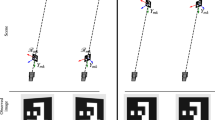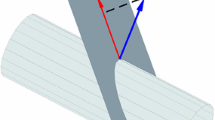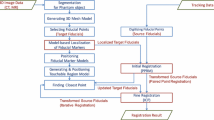Abstract
Purpose
Image Guided Surgery (IGS) navigation systems may acquire the position of an instrument relative to the patient with an infrared light–based stereo tracking camera. The measured instrument position is then transformed from the tracking coordinate system to the coordinate system of the intraoperatively acquired medical images.
Method
A robust and practical automatic method was developed to determine the coordinate transformation from the tracking device to intraoperatively acquired images. The method works with a patient reference device that contains both fluoroscopic markers and tracking markers in a defined geometric arrangement which is fixed on the patient. As precondition the patient reference must be acquired by at least two fluoroscopic images. From the positions of the fluoroscopic markers in these images, the location and orientation is determined and the tracking-to-image transformation is computed. 3D localization of the fluoroscopic reference markers is determined by a three-step process: marker detection, correspondence calculation and triangulation. These steps are implemented in an automatic and robust manner using a new correspondence calculation method.
Results
The improved SVD matching method was evaluated experimentally using both synthetic point sets and fluoroscopic marker sets detected from 66 image pairs from a bone and soft tissue phantom acquired by a fluoroscopic c-arm system (Siemens Artis zee Biplane system). For the ideal point sets without outliers 100% of the correspondences were correct. For the noised point sets with up to 20% rogue points 84% correspondence were correct. For lateral translations between the directions of acquisition, the normalized SVD matching method is shown to be as robust as the original approach proposed by Scott and Longuet-Higgins [15]. For other translations, rotations, scaling and shear transformations our method is more robust. The accuracy of the 3D reconstruction approach was also evaluated with a patient phantom. The experiment was repeated with projection images having variant C-arm angulations from 10° to 130°. The results showed that the mean 3D error of the reconstructed markers was 0.36 mm with a standard deviation of 0.096 mm.
Conclusion
The 3D reconstruction method enables an effective tool to relate a tracking system to a FD-CT imaging system and provide adequate accuracy for most navigation applications.
Similar content being viewed by others
References
Aguado AS, Montiel ME, Nixon MS (1995) Ellipse Detection via gradient direction in the Hough transform. Proc. IEE International Conference on Image Processing and its Applications, July, pp 375–378
Besl PJ, McKay ND (1992) A method for registration of 3-d shapes. IEEE Trans Pattern Anal Mach Intell 14(2): 239–256
Bezdek JC (1981) Pattern recognition with fuzzy objective function algorithms. Plenum Press, NY
Brost A, Strobel N (2009) Accuracy of X-Ray image-based 3D localization from two C-Arm views: A comparison between an ideal system and a real device. Medical Imaging 2009: Visualization, Image-Guided Procedures, and Modeling. Proceedings of the SPIE 7261:72611Z-72611Z-10
Chui H, Rangarajan A (2003) A new point matching algorithm for non-rigid registration. Comput Vis Image Underst 89: 114–141
Delponte E, Isgró F (2005) SVD-matching using SIFT features. In: Proceedings of the international conference on vision, video and graphics, pp 125–132
Delponte E (2005) Object recognition from local scale-invariant features. In: Proceedings of ICCV. Corfu, Greece, pp 1150–1157
Gold S, Rangarajan A, Lu CP, Pappu S, Mjolsness E (1998) New algorithms for 2D and 3D point matching: pose estimation and correspondence. Pattern Recognit 31(9): 1019–1031
Gonzalez RC, Richard E (2002) Woods digital image processing, 2nd edn. Prentice Hall, Englewood Cliffs
Hartley R, Zisserman A (n.d.) Multiple view geometry in computer vision, 2nd edn. Cambridge university press
Myronenko A, Song X, Carreira-Perpinan MA (2007) Non-rigid point set registration: coherent point Drift. In: NIPS, pp 1009–1016
Myronenko A, Song X, “Point set registration: coherent point drift. IEEE Trans Pattern Anal Mach Intell, 25 Feb. 2010. IEEE computer Society Digital Library. IEEE Computer Society
Pilu M (1997) Uncalibrated stereo correspondence by singular value decomposition. Computer Vision & Pattern Recognition
Rangarajan A, Chui H, Mjolsness E, Davachi L, Goldman-Rakic PS, Duncan JS (1997) A robust point matching algorithm for autoradiograph alignment. Med Image Anal 4(1): 379–398
Scott GL, Longuet-Higgins HC (1991) An algorithm for associating the features of two images. Proc. Royal Soc. Lond. Series B 244(1309): 21–26
Shapiro SS, Wilk MB (1965) An analysis of variance test for normality. Biometrika 52(3–4): 591–611. doi:10.1093/biomet/52.3-4.591. JSTOR2333709 MR205384
Shapiro L, Brady J (1992) Feature-based correspondence: an eigen vector approach. Image Vis Comput 10(5): 283–288
Umeyama S (1988) An eigen decomposition approach to weighted graph matching problems. Pattern Anal Mach Intell 10(5): 695–703
Wang H, Suter D LTSD: A highly efficient symmetry-based robust estimator. In: Seventh international conference control, automation, robotics and vision (ICARCV’02), pp 332–337
Zheng Y, Doermann D (2006) Robust point matching for non-rigid shapes: a relaxation labeling based approach. IEEE Trans Pattern Mach Intell 28(4): 643–649
Author information
Authors and Affiliations
Corresponding author
Rights and permissions
About this article
Cite this article
Wei, W., Schön, N., Dannenmann, T. et al. Determining the position of a patient reference from C-Arm views for image guided navigation. Int J CARS 6, 217–227 (2011). https://doi.org/10.1007/s11548-010-0502-z
Received:
Accepted:
Published:
Issue Date:
DOI: https://doi.org/10.1007/s11548-010-0502-z




